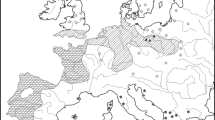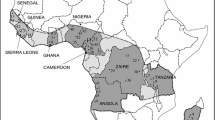Abstract
Genetic variation has been assessed in 30 populations (931 families) ofFaidherbia albida (Leguminosae, Mimosoideae) from across its entire African range, using six isozyme loci identified by five enzyme systems. Among the populations studied a null allele was proposed to explain the absence ofLap-1 activity in populations from southern and eastern Africa. The mean percentage of polymorphic loci per population, the mean number of alleles per locus and the mean genetic diversity within populations were 31.7%, 1.6 and 0.127 respectively. Genetic diversity was greatest in populations from West Africa and lowest in populations from eastern/southern Africa, with Ethiopian/Sudanese populations intermediate. The overall degree of genetic differentiation between populations (GST) indicated that approximately 56% of the enzyme variation resided within populations. Clustering of Nei's unbaised genetic distances calculated between all populations produced a dendrogram that generally followed the geographic distribution of the populations. Two major groups were identified that may be considered the eastern/southern African and the Ethiopian/West African clusters. Within the Ethiopian/West African cluster two subclusters could be recognised, one broadly corresponding to those populations from Ethiopia/Sudan and the other to those populations from West Africa. The implications of these results for theories regarding the origin ofF. albida in Africa are discussed.
Similar content being viewed by others
References
Aubréville, A., 1950: Flore forestière Soudano-Guinéene. — Cameroun, A.E.F.: A.O.F.
Brenan, J. P. M., 1959:Leguminosae subfamilyMimosoideae. — InHubbard, C. E., Milne-Redhead, E., (Eds): Flora of tropical East Africa, pp. 1–173. — London: Crown Agents.
, 1983: Manual on taxonomy ofAcacia species: present taxonomy of four species ofAcacia (A. albida, A. senegal, A. nilotica, A. tortilis). — Rome, Italy: Food and Agriculture Organization.
Chappill, J. A., Maslin, B. R., 1995: A phylogenetic assessment of tribeAcacieae. — InCrisp, M., Doyle, J. J., (Eds): Advances in legume systematics7: phylogeny, pp. 77–99. — Kew: Royal Botanic Gardens.
Chevalier, A., 1928: Révision des Acacias du Nord, de I'Ouest et du centre African. IV, Le bois de Acacias. — Rev. Bot. Appl, Agric. Colon.8: 646–650.
Fagg, C. W., 1992: Germplasm collection ofFaidherbia albida in eastern and southern Africa. — InVan den Beldt, R. J., (Ed.):Faidherbia albida in the West African semi-arid tropics, pp. 19–24. — Nimey, Niger: ICRA.
Gregorius, H., 1984: A unique genetic distance. — Biometr. J.26: 13–18.
Guinet, P., 1981:Mimosoideae: the characters of their pollen grains. — InPolhill, R. M., Raven, P. H., (Eds): Advances in legume systematics2, pp. 835–857. — Kew: Royal Botanic Gardens.
Hamrick, J. L., Loveless, M. D., 1989: The genetic structure of tropical tree populations: Associations with reproductive biology. — InBock, J. H., Linhart, Y. B., (Eds): The evolutionary ecology of plants, pp. 129–146. — Boulder, Colorado: Westville Press.
Harlan, J. R., 1975: Crops and man. — Madison, Wisconsin: American Society of Agronomy.
, (Eds), 1976: The origins of African plant domestication. — The Hague: Mouton.
Hauser, T. P., 1994: Germination, predation and dispersal odAcacia albida seeds. — Oikos71: 421–426.
Hervouet, J. P., 1992:Faidherbia albida: a witness of agrarian transformation. — InVan den Beldt, R. J., (Ed):Faidherbia albida in the West African semi-arid tropics, pp. 165–169. — Niamey, Niger: ICRA.
Joly, H. I., Zeh-Nlo, M., Danthu, P., Aygalent, C., 1992: Population genetics of an African Acacia,Acacia albida. I. Genetic diversity of populations from West Africa. — Austral. J. Bot.40: 59–73.
Maumont, S., 1992: Phylogenetic relationships among theAcacieae andIngeae (Leguminosae, Mimosoideae): preliminary results from chloroplast DNA restriction fragment analysis. — In: Third International Legume Conference, poster abstracts, Kew, Royal Botanic Gardens.
Moran, G. F., Muona, O., Bell, J. C., 1989:Acacia mangium a tropical forest tree of the coastal lowlands with low genetic diversity. — Evolution43: 231–235.
Nei, M., 1973: Analysis of genetic diversity in subdivided populations. — Proc. Natl. Acad. Sci. USA70: 3321–3323.
, 1978: Estimation of average heterozygosity and genetic distance from a small number of individuals. — Genetics89: 583–590.
, 1987: Molecular evolutionary genetics. — New York: Columbia University Press.
Nongonierma, A., 1976: Contribution à l'étude du genreAcacia Miller en Afrique occidentale. II. Caracteres des inflorescences et des fleurs. — Bull. Inst. Franc. Afrique Noire, Sér. A.38: 487–657.
Ross, J. H., 1979: A conspectus of the AfricanAcacia species. — Mem. Bot. Surv. S. Africa44: 155.
Sniezko, R. A., Stewart, H. T. L., 1989: Range-wide provenance variation in growth and nutrition ofAcacia albida seedlings propagated in Zimbabwe. — Forest Ecol. Managem.27: 179–198.
Sneath, P. H. A., Sokal, R. R., 1973: Numerical taxonomy. — San Francisco: Freeman.
Swofford, D. L., Selander, R. B., 1981: Biosys-1: a FORTRAN program for the comprehensive analysis of electrophoretic data in population genetics and systematics. — J. Heredity72: 281–283.
Van den Beldt, R. J., 1990: Differences in rooting patterns between western and southern African origins ofFaidherbia albida A. Chev. — Nitrogen Fixing Tree Res. Rep.8: 136–137.
Vassal, J., 1981:Acacieae Benth. — InPolhill, R. M., Raven, P. H., (Eds): Advances in legume systematics1, pp. 169–171. — Kew: Royal Botanic Gardens.
Weeden, N. F., Wendel, J. F., 1990: Genetics of plant isozymes. — InSoltis, D. E., Soltis, P. S., (Eds): Isozymes in plant biology, pp. 46–72. — London: Chapman & Hall.
White, F., 1983: The vegetation of Africa: a descriptive memoir to accompany the UNESCO/AETFAT/UNSO vegetation map of Africa byF. White. — Paris: UNESCO.
Wickens, G. E., 1969: A study ofAcacia albida Del. (Mimosoideae). — Kew Bull23: 181–202.
Wilson, H. D., Barber, S. C., Walters, T., 1983: Loss of duplicated gene expression in tetraploidChenopodium. — Biochem. Syst. Ecol.11: 7–13.
Wright, S., 1978: Evolution and the genetics of populations.4. Variability within and among natural populations. — Chicago, Illinois: University of Chicago Press.
Zeh-Nlo, M., 1989: Contribution à l'étude de la diversité génétique deAcacia albida Del. approche par électrophorése isoenzymatique. — M.Sc. Thesis, Université de Nancy I.
Author information
Authors and Affiliations
Rights and permissions
About this article
Cite this article
Harris, S.A., Fagg, C.W. & Barnes, R.D. Isozyme variation inFaidherbia albida (Leguminosae, Mimosoideae). Pl Syst Evol 207, 119–132 (1997). https://doi.org/10.1007/BF00985213
Received:
Revised:
Accepted:
Issue Date:
DOI: https://doi.org/10.1007/BF00985213




